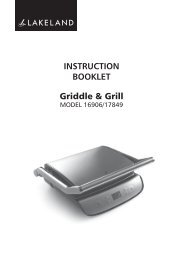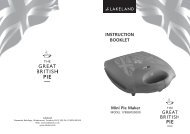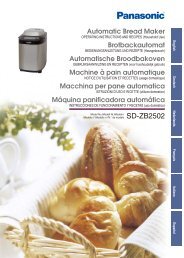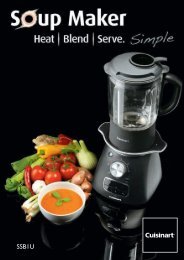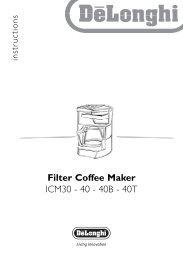Food Dehydrator Instructions - Lakeland
Food Dehydrator Instructions - Lakeland
Food Dehydrator Instructions - Lakeland
Create successful ePaper yourself
Turn your PDF publications into a flip-book with our unique Google optimized e-Paper software.
MK <strong>Food</strong> <strong>Dehydrator</strong> 14210 IB A:Layout 1 31/3/10 11:48 Page 1<br />
The <strong>Lakeland</strong> Guarantee....<br />
is probably the simplest guarantee in the world!<br />
If you are not satisfied at any time, you receive your money back!<br />
This is our promise.<br />
<strong>Lakeland</strong><br />
Alexandra Buildings, Windermere, Cumbria LA23 1BQ<br />
Tel: 015394 88100 Web: www.lakeland.co.uk<br />
USER MANUAL<br />
FOOD DEHYDRATOR<br />
Model: 14210<br />
Helpline No: 015394 88100
MK <strong>Food</strong> <strong>Dehydrator</strong> 14210 IB A:Layout 1 31/3/10 11:48 Page 3<br />
INTRODUCTION<br />
Thank you for choosing this food dehydrator from My Kitchen, a hard-working range of<br />
everyday cooks’ essentials by <strong>Lakeland</strong>. The food dehydrator preserves fresh fruit,<br />
vegetables and herbs by circulating hot air around them to remove their moisture<br />
content. Natural flavours and sweetness are concentrated and, once dried, the food has<br />
a much longer shelf life than fresh produce. Please take a few moments to read these<br />
instructions before using your food dehydrator for the first time, and keep them in a<br />
safe place for future reference.<br />
FEATURES<br />
1. Top lid<br />
2. Adjustable food trays<br />
3. Heated base<br />
4. On/off switch<br />
Operating voltage: 220-240V~ 50Hz<br />
Power: 250W<br />
IMPORTANT SAFEGUARDS<br />
When using this food dehydrator, please follow these basic safety precautions.<br />
1. Please read all instructions before using.<br />
2. Make sure your electricity supply matches the voltage shown on the appliance.<br />
3. This food dehydrator is for household use only. It is not suitable for commercial<br />
use, or for use outdoors. The food dehydrator must only be used for its intended<br />
purpose of drying fresh fruit, vegetables and herbs.<br />
4. Place the food dehydrator on a dry, level and HEATPROOF surface. Do not let the<br />
power cord touch any hot surfaces or hang over the edge of your worktop, where<br />
a child could grab it.<br />
5. Do not place the food dehydrator on or near a hot gas or electric burner, or in or<br />
near a heated oven.<br />
6. The food dehydrator will get hot during use. Take care not to touch the hot<br />
surfaces, and let food cool before handling it.<br />
7. Keep the food dehydrator well away from curtains, wall cabinets, clothing, tea<br />
towels etc. Do not place anything on top of the appliance during use.<br />
8. Always switch off and unplug the food dehydrator before adding or removing the<br />
trays, when not in use and before cleaning. Grasp the plug, not the cord. Let the<br />
food dehydrator cool down completely before cleaning.<br />
9. To avoid electric shock, do not let the food dehydrator, power cord or plug get<br />
wet. Never immerse the base in water or any liquid when cleaning. Do not touch<br />
with wet hands.<br />
10. Using accessories that are not recommended by the manufacturer may cause<br />
fire, electric shock or injury, and should be avoided.<br />
11. The food dehydrator is not intended for use by children or infirm people unless<br />
they have been adequately supervised by a responsible person to ensure they<br />
can use it safely. Children should be supervised to ensure they do not play with<br />
the food dehydrator.
MK <strong>Food</strong> <strong>Dehydrator</strong> 14210 IB A:Layout 1 31/3/10 11:48 Page 5<br />
12. Do not use the food dehydrator if the power cord or plug show any signs of<br />
damage, or if the appliance is dropped, damaged or working incorrectly. Call the<br />
helpline on 015394 88100 to arrange a repair by an authorised repairer, or a<br />
replacement. Never try to repair the food dehydrator yourself as this may cause<br />
electric shock.<br />
BEFORE USING FOR THE FIRST TIME<br />
Carefully unpack the food dehydrator and remove any packaging. Wash the lid and food<br />
trays in hot, soapy water, or in the dishwasher. Rinse and dry. Wipe the base with a<br />
slightly damp cloth, then dry. It must never be immersed in water or any liquid.<br />
AN INTRODUCTION TO FOOD DEHYDRATING<br />
Dehydrating is an age-old method of preserving fresh food. Today, this food dehydrator<br />
offers a simple and effective way to dry a wide variety of fruit, vegetables and herbs.<br />
It consists of a heated base and 5 stacking food trays which can be adjusted to hold<br />
thin or thick food. The base heats up to 85°C whilst a fan circulates hot air around the<br />
food to remove its moisture content.<br />
The drying process concentrates natural flavour, making for tasty ingredients such as<br />
dried mushrooms, tomatoes and herbs which will enhance your soups, stews,<br />
casseroles and sauces. Dried fruits make an enjoyable, healthy snack and can also be<br />
added to home baking.<br />
Drying times vary greatly according to the kind of food selected, the thickness and size<br />
of the pieces, and even the temperature of your kitchen. You may find it helpful to keep<br />
a record of how long different types of fruit and veg take to dry; you will soon get a feel<br />
for how long they take and how best to prepare them. See FOOD DRYING GUIDE.<br />
USING YOUR FOOD DEHYDRATOR<br />
1. Firstly, place the food dehydrator onto a heatproof surface, well away from<br />
curtains, tea towels etc, with proper ventilation space around it. It will get very<br />
hot during use and your worktop or table should be protected from the heat<br />
generated by the appliance.<br />
2. Prepare the food – see FOOD DRYING GUIDE – and place it on the trays. Take care<br />
not to overload the trays or to overlap the food; the hot air should be able to<br />
circulate freely. Leave the central hole uncovered.<br />
3. Making sure the base is switched off and unplugged, stack the trays onto it. We<br />
recommend stacking all 5 trays, even if some of them are empty. Trays containing<br />
food should be placed at the top of the stack.<br />
TIP: to check the trays are the right way up, look at them sideways on. The top of the<br />
tray is narrower than the bottom.<br />
4. The height of each tray can be adjusted to suit thick food up to 2.5cm e.g. broccoli<br />
florets, or thin food up to 1.25cm e.g. banana slices. The trays can be stacked in<br />
any combination and each tray has smooth and ribbed stacking tabs on the side.<br />
For THICK food, stack the trays as shown below, with the smooth tab of the upper tray<br />
sitting on top of the ribbed tab of the lower tray.<br />
For THIN food, rotate the upper tray so that its smooth tab sits next to the ribbed tab<br />
of the lower tray, as shown below.<br />
5. Place the lid on the top tray. CAUTION; the food dehydrator should never be used<br />
without the lid. Plug in the food dehydrator and press the on/off switch on the<br />
base. The switch will light up red and you will hear the fan working.<br />
6. When the food is dry, press the on/off switch and unplug the food dehydrator. Let<br />
it cool completely before lifting off the trays, removing the food and cleaning. See<br />
CARE AND CLEANING. Take care when handling the food; it may be hot.<br />
7. Once the food has cooled completely, store it in airtight containers, labelling and<br />
dating the contents. Store in a cool, dry, dark place and check monthly for<br />
spoilage.
MK <strong>Food</strong> <strong>Dehydrator</strong> 14210 IB A:Layout 1 31/3/10 11:48 Page 7<br />
FOOD DRYING GUIDE<br />
There are no hard-and-fast rules when it comes to food dehydrating. This guide offers<br />
a helpful starting point. Over time you will develop a feel for how long different fruit<br />
and vegetables take to dry. The best way is to experiment with different ingredients<br />
and to keep a record of what works for you.<br />
1. For the best flavour and colour, begin with fresh, fully ripe fruit, veg or herbs.<br />
Rinse thoroughly and pat dry with kitchen paper. Discard any damaged, bruised<br />
or mouldy pieces.<br />
2. Prepare the produce as below. <strong>Food</strong> will dry more evenly if the pieces are sliced<br />
to about the same thickness. Thick pieces dry more slowly than thin slices. Fruits<br />
should be sliced across the core. A food processor is ideal for fast, even slicing.<br />
With so many factors affecting drying times – the type of food, the thickness or size of<br />
the pieces, the room temperature – it is impossible to give exact timings. Check the<br />
food regularly, letting it cool before handling it to check for doneness. TIP: it is better<br />
for food to be slightly over-dry than under-dry as moist food is more likely to spoil<br />
during storage.<br />
FRUIT<br />
To help preserve the natural sweetness, flavour and colour of fruit, we recommend pretreating<br />
it before drying. Soak the fruit for around 2 minutes in 480ml water, to which<br />
60ml fruit juice has been added. Where possible, the juice should match the fruit to be<br />
dried e.g. apple juice for apples. This method of pre-treating will give the best results.<br />
FRUIT PREPARATION DRYNESS TEST APPROX. DRYING TIME<br />
Apples<br />
Apricots<br />
Bananas<br />
Peel and core.<br />
Cut into rings<br />
Halve or slice.<br />
Remove pit.<br />
Peel and cut into<br />
3mm slices.<br />
Pliable 5-6 hours<br />
Pliable<br />
12-38 hours<br />
Crisp 8-38 hours<br />
Cranberries Chop or leave whole. Pliable 6-26 hours<br />
Dates Pit and slice. Leathery 6-26 hours<br />
Grapes Leave whole. Pliable 8-38 hours<br />
Orange zest Peel in long strips. Brittle 8-16 hours<br />
Strawberries Cut into 1cm slices. No moisture 8-26 hours<br />
VEGETABLES<br />
We also recommend pre-treating certain types of vegetable before drying: green beans,<br />
broccoli, cauliflower, asparagus and potatoes. Blanching the prepared vegetables in a<br />
pan of boiling water for 3 to 5 minutes will help to keep their natural colour. Strain and<br />
pat dry with kitchen paper before drying.<br />
Prepared vegetables can also be dipped in lemon juice for 2 minutes to add a hint of<br />
lemon flavour, if desired. This is especially recommended for green beans and<br />
asparagus.<br />
VEGETABLE PREPARATION DRYNESS TEST APPROX. DRYING TIME<br />
Asparagus<br />
Beans<br />
Broccoli<br />
Cabbage<br />
Carrots<br />
Cauliflower<br />
Blanch.<br />
Cut into 2cm pieces.<br />
Cut and blanch.<br />
until translucent<br />
Trim and cut. Steam<br />
until tender<br />
Trim and cut leaves into<br />
5mm strips<br />
Steam until tender.<br />
Shred or slice.<br />
Trim and cut. Blanch.<br />
until tender<br />
Brittle 6-14 hours<br />
Brittle<br />
8-26 hours<br />
Brittle 6-20 hours<br />
Leathery 6-14 hours<br />
Leathery 6-16 hours<br />
Leathery 6-16 hours<br />
Chives Chop to desired size. Brittle 6-10 hours<br />
Garlic<br />
Mushrooms<br />
Peel clove and slice<br />
thinly.<br />
Slice, chop or leave<br />
whole<br />
Onions Chop or slice thinly. Brittle<br />
Peppers<br />
Potatoes<br />
Tomatoes<br />
Cut into 5mm rings or<br />
strips. Remove seeds<br />
Slice or dice. Steam<br />
blanch for 8-10 minutes<br />
Remove skin. Halve or<br />
slice.<br />
Brittle 6-16 hours<br />
Leathery 6-14 hours<br />
8-14 hours<br />
Brittle 4-14 hours<br />
Brittle<br />
6-18 hours<br />
Leathery 8-24 hours
MK <strong>Food</strong> <strong>Dehydrator</strong> 14210 IB A:Layout 1 31/3/10 11:48 Page 9<br />
HERBS<br />
To make your own dried herbs, begin by rinsing fresh herbs and shaking off the excess<br />
water. Remove any dead or discoloured leaves, and leave the herbs on the stem for<br />
drying.<br />
Spread herbs loosely on the tray and dry for approx. 2 to 6 hours. Drying times will vary<br />
according to size and type. Once the herbs are dried, let them cool completely, remove<br />
the leaves from the stem and store in an airtight container.<br />
HELPFUL HINTS<br />
• Spray the trays with non-stick cooking spray for easier removal of dried food.<br />
• Check your food every hour for doneness.<br />
• Rotate the trays to promote even drying. Firstly, switch off and unplug the food<br />
dehydrator. Lift off the trays in one stack and remove the lid. Swap over the top<br />
and bottom trays, then return the whole stack to the base. Replace the lid. Plug<br />
in and switch on the food dehydrator. Rotate again as required. CAUTION: please<br />
wear oven gloves to protect your hands from hot surfaces.<br />
SERVING SUGGESTIONS<br />
Dried fruit has a wonderful, natural sweetness and concentrated flavour. Tasty, readyto-eat<br />
fruit snacks such as apple rings and banana chips can be made for a fraction of<br />
the cost of commercially dried fruit. Try adding dried fruits to breakfast cereal, muesli,<br />
natural yoghurt or home baking, such as flapjacks and cookies. Or, soak the fruit in<br />
water to rehydrate, and make compotes, fruity sauces, pies or crumbles.<br />
Dried vegetables may benefit from being soaked in water to rehydrate them before<br />
adding to all kinds of home-made soups, stews, casseroles and sauces such as<br />
Bolognese. Dried mushrooms, tomatoes and herbs make tasty ingredients. You might<br />
like to try making vegetable crisps with wafer-thin slices of dried parsnip, courgette,<br />
aubergine, beetroot etc. Dry until very brittle, allow to cool, then sprinkle with salt and<br />
pepper for a delicious savoury snack.<br />
CARE AND CLEANING<br />
Switch off and unplug the food dehydrator. Remove the lid and trays, and let everything<br />
cool before cleaning. Wash the lid and trays in warm, soapy water, or place in your<br />
dishwasher. Rinse and dry.<br />
Wipe the cooled base with a slightly damp cloth, then dry. Never use abrasive cleaners<br />
or metal scourers. To avoid electric shock, the base must not be immersed in water or<br />
any liquid. For compact storage, stack the food trays at their lowest height and place<br />
on top of the base.<br />
RECYCLING YOUR ELECTRICALS<br />
Along with many other high street retailers, <strong>Lakeland</strong> has joined a scheme whereby<br />
customers can take their unwanted electricals to recycling points set up around the<br />
country. Visit www.recycle-more.co.uk to find your nearest recycling point.
MK <strong>Food</strong> <strong>Dehydrator</strong> 14210 IB A:Layout 1 31/3/10 11:48 Page 11<br />
ELECTRICAL CONNECTIONS<br />
THIS APPLIANCE MUST BE EARTHED<br />
This appliance is fitted with a fused three-pin plug to BS1363 which is suitable for use in all homes<br />
fitted with sockets to current specifications. If the fitted plug is not suitable for your socket<br />
outlets, it should be cut off and carefully disposed of. To avoid an electric shock, do not insert the<br />
discarded plug into a socket.<br />
Fitting a new plug<br />
If for any reason you need to fit a new plug, the flexible mains lead must be connected as shown<br />
here. The wires in the mains lead fitted to this appliance are coloured in accordance with the<br />
following code:<br />
Neutral(blue)<br />
Earth(green/yellow)<br />
N<br />
E<br />
L<br />
Connect BLUE to Neutral (N)<br />
Connect GREEN & YELLOW to Earth (E)<br />
Connect BROWN to Live (L)<br />
13 amp fuse to be used<br />
13amp FUSE<br />
Live(brown)<br />
13amp fuse<br />
If the colours of the wires in the mains lead of this appliance do not correspond with the coloured<br />
markings identifying the terminals in your plug, proceed as follows. The wire which is coloured<br />
green and yellow MUST be connected to the terminal which is marked with the letter E (Earth) or<br />
coloured green. The wire which is coloured blue MUST be connected to the terminal which is<br />
marked with the letter N (Neutral) or coloured black. The wire which is coloured brown MUST be<br />
connected to the terminal which is marked with the letter L (Live) or coloured red.<br />
Before refitting the plug cover, check that there are no cut or stray strands of wire inside the plug.<br />
Use a 13 amp BS1362 fuse. Only BSI or ASTA approved fuses should be used. If you are at all unsure<br />
which plug or fuse to use, always refer to a qualified electrician.<br />
Note: after replacing or changing a fuse on a moulded plug which has a fuse cover, the cover must<br />
be refitted to the plug; the appliance must not be used without a fuse cover. If lost, replacement<br />
fuse covers can be obtained from an electrical shop. This appliance complies with the following<br />
EEC Directives: 73/23 EEC (Low Voltage Directive) and 89/336 EEC (EMC Directive).<br />
0001




